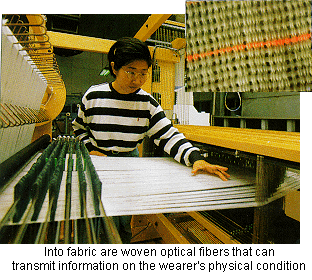

By Victor Rogers
![]() he old military issue T-shirt and dog tags are taking on new meaning
and could someday save lives on the battlefield, thanks to a new "woven
computer" developed by Georgia Tech.
he old military issue T-shirt and dog tags are taking on new meaning
and could someday save lives on the battlefield, thanks to a new "woven
computer" developed by Georgia Tech.
Created for the Navy Department, the "Sensate Liner for Combat Casualty Care" uses optical fibers to detect bullet wounds and special fibers to monitor vital signs during combat. The T-shirt functions like a computer, with plastic optical and conducting fibers woven throughout the fabric.

"The idea is to send a 'signal' from one end of the plastic optical fiber to a receiver at the other end," said Dr. Sundaresan Jayaraman, a professor in the School of Textile, and Fiber Engineering and the prin cipal investigator of the project. "If the light from one end does not reach the other end, we know the Sensate Liner has been penetrated (i.e., the soldier has been shot)." A signal bounces back to the first receiver from the point of penetration, helping the medical personnel pinpoint the exact location of the soldier's wound.
The receiver is a Personal Status Monitor (PSM)--the 21st century version of a dog-tag--and is worn, at hip- level by the soldier. In a combat situation, the plastic optical fiber senses the penetration of a bullet and sends the information to the PSM. The soldier's vital signs-heart rate, temperature, blood pressure, etc.--are monitored in two ways: through the sensors woven into the T-shirt and through sensors on the soldier's body, both of which are connected to the PSM.
Information on the wound and the soldier's condition is transmitted from the PSM to a medical triage unit somewhere near the battlefield. The triage unit then dispatches the appropriate medical personnel to the scene.
"The Sensate Liner can help a physician determine the extent of a soldier's injuries based on the strength of his heartbeat and respiratory rate," Jayaraman said. "This information is vital for assessing who needs assistance first during emergency situations in which there are numerous casualties."
In addition to military applications, the Sensate Liner or its monitoring component alone could be used by law enforcement personnel, astronauts, athletes--even to protect sleeping children from Sudden Infant Death Syndrome.
The Sensate Liner, which is still in the development phase, is expected to cost between $25 and $35. Testing of a prototype is scheduled for next spring in coordination with the Navy.